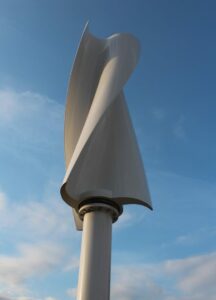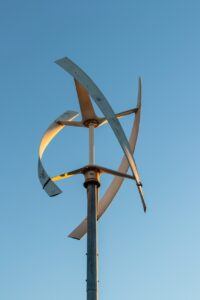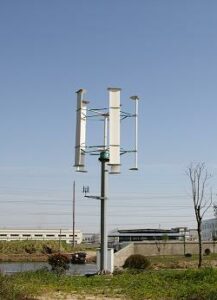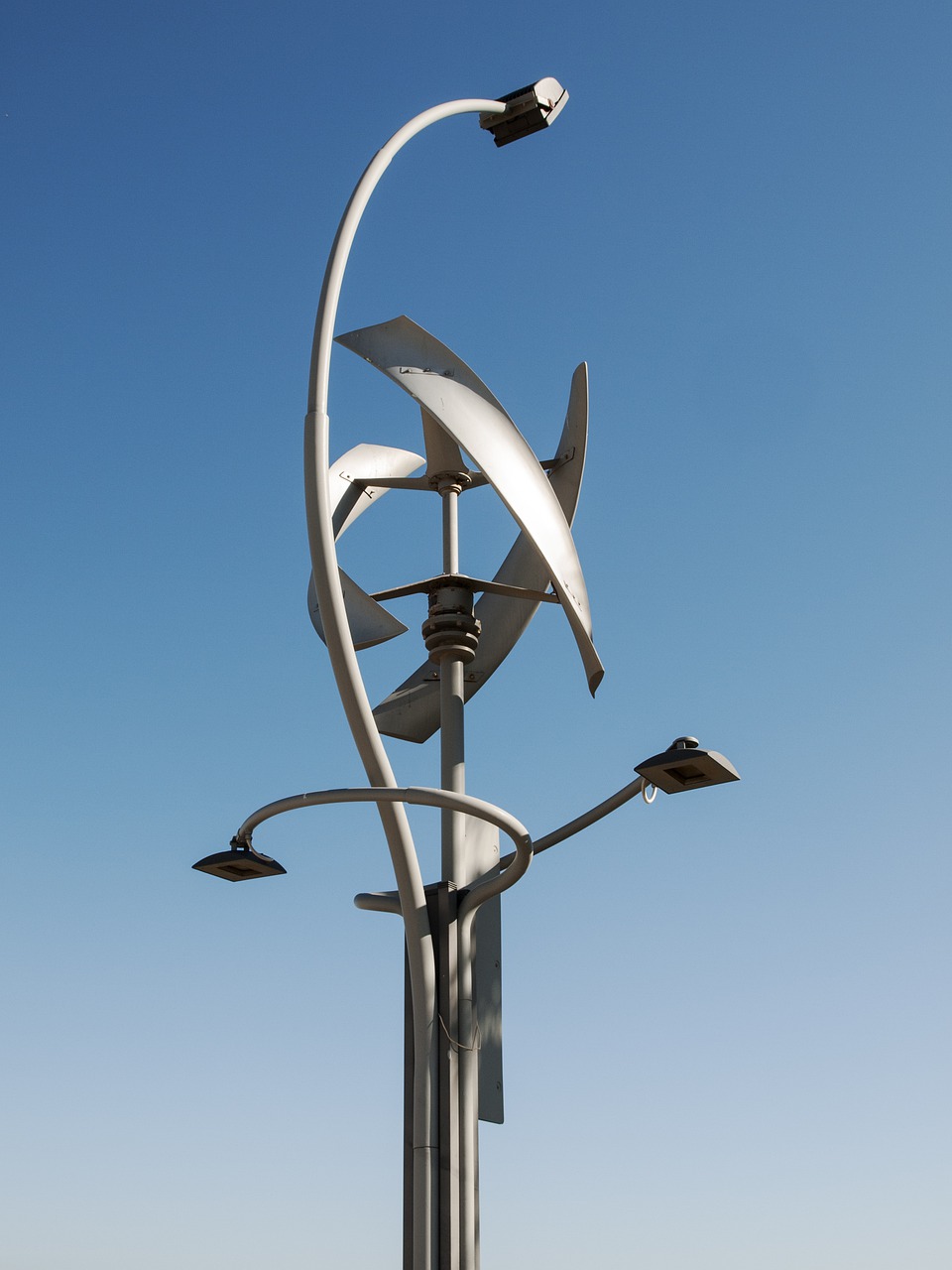When someone mentions wind turbines, you immediately think of the large propeller-like windmills that dot coastal or rural landscapes nowadays. But did you know there is another type of wind generator called a vertical axis wind turbine, or VAWT. So, what is a vertical wind turbine?
HAWT vs. VAWT
Wind generators are classified into two different varieties – horizontal axis wind turbines (HAWT) and vertical axis wind turbines (VAWT). The distinction between the two types come from the orientation of the rotating shaft that the blades are attached to. For horizontal axis wind turbines, the rotor shaft is horizontal, or parallel, to the ground, whereas the rotor shaft of a vertical axis wind turbine stands upright at 90° (or perpendicular) to the ground. The best way to remember the difference between the two is that most VAWT look like upside-down egg-beaters!
VAWT in 60 seconds

The VAWT family consists of two major models – the Darrieus rotor and the Savonius rotor. Each type uses a different principle of aerodynamics – lift or drag – to rotate and generate power.
The Savionus model VAWT typically consists of two or three ‘scoops’ attached to the vertical shaft. The drag experienced by the scoops on the front face (cup) is greater than the drag felt on the back of the scoop and this difference in drag causes the turbine to spin.
Because Savonius rotors are very simple in their design, they are best used where cost and reliability are more important than energy efficiency. Ironically, the most common use of the Savonius rotor is not generating electricity from wind but providing cooling and ventilation for vans and buses.

The Darrieus model comprises a number of wing-shaped blades, or aerofoils, mounted on the vertical shaft. Original designs had 2 – 3 straight blades held at parallel to the axis using metal supports. As air moved around the blades this generated lift (like an aircraft wing) and the turbine would spin. However, it also created huge centrifugal forces in the blades as they spun, causing them to rapidly fatigue and break in some cases.
This problem was addressed by introducing helical aerofoils which acts to spread forces more evenly throughout the blade as the rotor spins, thereby reducing the potential for turbine destruction. Mechanical braking systems or speed controls are also used to manage the torque (rotational) loadings on the rotor.
Darrieus VAWT operate at high RPM (revolutions per minute), low torque and greater efficiency than Savonius rotors and are therefore better suited to generating electricity.
Why Most Vertical Wind Turbines Fail
Vertical wind turbines are often touted by their manufacturers as a superior substitute for horizontal wind turbines, particularly in urban settings, because they take up less space, are quieter and can be mounted on rooftops. Also, VAWT can supposedly handle wind from all directions and even turbulent air better than HAWT. Low wind speeds, again no problem.
At this stage, you might be tempted to ask, “If vertical wind turbines are so good, why don’t we see more of them around the place?” Good question.
Perhaps to answer this question, we should examine each of the major claims about VAWT superiority in turn and determine whether or not VAWTs offer a significant advantage over their horizontal siblings. The key to remember here is that whatever wind turbine you use, it must be able to deliver the power output (kWh) you need to supplement your grid power or generate your home’s entire electricity supply.
CLAIM #1 – VAWT capture the wind from all directions
The claim is often made that vertical wind turbines can handle wind from all directions and do not need the yaw and pitch controls of HAWTs to track the wind for maximum power generation. Well, home-scale HAWTs are designed to track the wind, usually with large fixed tails (just like an airplane) so as to orientate the turbine assembly into the wind. Therefore, VAWTs have no advantage over HAWTs in this regard.
CLAIM #2 – VAWT handle turbulent airflow better
As we have already discovered, turbulence is the silent killer of wind turbines both in terms of energy collected from the wind and its impact on mechanical components. Turbines constantly start and stop in turbulent air, reducing the amount of electricity that can be generated. Uneven wind loadings on the blades and bearings increase wear and tear, leading to the eventual destruction of the turbine assembly. No wind turbine should ever be deliberately located in turbulent air. No advantage here.
CLAIM #3 – VAWT perform better in low wind speeds
Low wind speeds means low energy and therefore low power (kWh) output. According to the UK-based Institute of Mechanical Engineers, vertical axis wind turbines are very inefficient – one VAWT produces less than 1% of the output of an equivalent HAWT. Remember, the key is to harvest more power from the wind, not less! Still no advantage over HAWT.
CLAIM #4 – VAWT can be mounted on your rooftop or a short tower
 By mounting the VAWT on your roof or a short tower on the ground, you are condemning the turbine to forever working in the turbulent air generated either by buildings or friction along the ground. As explained earlier, turbulence robs the turbine of any harvestable energy. Early call, no advantage.
By mounting the VAWT on your roof or a short tower on the ground, you are condemning the turbine to forever working in the turbulent air generated either by buildings or friction along the ground. As explained earlier, turbulence robs the turbine of any harvestable energy. Early call, no advantage.
Furthermore, vibration and noise throughout the house from the VAWT tower will likely be a problem unless you take steps to insulate the turbine mount where it attaches to the house. This can be very expensive to remedy.
Moral of the story: Don’t mount your turbine on the roof or on a short tower.
CLAIM #5 – VAWT are less of a threat to wildlife
There is very little evidence to suggest that VAWT are any safer for birds and other wildlife that HAWT. With VAWTs making up an almost negligible percentage of the wind turbine market, collecting reliable and statistically significant data to demonstrate beyond all doubt that VAWTs are safer for wildlife than HAWTs would be impractical and costly.
Existing buildings, structures and environmental hazards kill more birds and bats each year than any wind turbine does. In fact, the UK-based Royal Society for the Protection of Birds (RSPB) stated that climate change poses the single greatest long-term threat to birds and other wildlife, not the renewable energy wind generators that are trying to help prevent this existential threat to all life on the planet. You guessed it, no advantage here either.
Beyond the Hype
Pure and simple, if you are investing in a wind power system, you want something that is proven and will deliver the energy output (kWh) needed to power your home. End of story.
VAWT have no genuine advantages over HAWT whatsoever despite their manufacturers’ claims. And VAWT manufacturers are not doing their products any favours by obscuring the all-important power production curves (kWh) from scrutiny either. Interestingly, one VAWT supplier we came across while researching this article plainly states in its marketing material that the customer should not focus on the energy production (output) of the VAWT at all and instead pay attention to its pleasant design and quietness. That should raise suspicions in any reasonable-minded person right there.
Unless you are in the market for a new backyard toy or a talking piece at your next garden party, stick with HAWT for power production in your home.
Having said that, we won’t write off VAWT totally just yet. Wind turbine technology is innovating and improving all the time. There may come a day when vertical wind turbines can achieve a similar, if not superior, output to an equivalent horizontal wind turbine. And we would welcome that. However, further work needs to be done on the performance, efficiency, reliability and economics of VAWT if they are to ever stand a chance of competing effectively with their horizontal brethren.
For now, it would appear the global market for wind turbines has decided which type of turbine produces the best returns for its investment.

Hi friend,
I’m an engineer and you bring me back to Vertical Wind Turbines. That time when I did my research at an engineering faculty, we (team) made a new design for Vertical Wind Turbines to increase the efficiency. Yes, I agree that Vertical Wind Turbines are less efficient than a horizontal one.
I don’t have a turbine at home, but it is really great way to generate electricity instead of expensive solar cells. Your overall article is just filled with correct info. So are you engineer or just do it as a hobby?
Do you have one at your home, can you share yours with us in a separate post?
All the best.
Thank you Safia for sharing your experience of vertical turbines with us. The fact that you got to design and build a VAWT from scratch to improve the power generation capabilities is really amazing. It is frustrating that VAWT are such poor electricity generators as I can see real benefit for urban homeowners and commercial buildings in providing another turbine option, if only they could produce a usable amount of power.
Wind turbines are both a passion and hobby for me, but I guess it also helps having been an aircraft engineer in a previous career. As much as I would love to install a wind turbine where we live, our landlord won’t allow it (I have asked). Definitely on the plans for our next place and I will be sharing!
Thanks for sharing this educative article explaining why most vertical wind turbines fail. Well, I am not familiar with vertical wind turbines like I am familiar with horizontal wind turbines. We didn’t cover much vertical wind turbine in school. The purpose of a wind turbine is to generate sufficient amounts of energy required for an application. So it didn’t make sense when VAWT manufacturers say we shouldn’t be concerned with the power of the turbine. No wonder they aren’t popular.
Hi MrBiizy and thank you for your feedback. You’re right, VAWT aren’t popular, largely because they don’t do what they are supposed to do which is generate large amounts of electricity. What I find even more frustrating is that throughout my research I have really struggled to find much positive feedback from all of these ‘satisfied’ customers that a number of VAWT manufacturers boast of in their marketing material. Maybe these customers are too embarrassed to admit they bought a dud.
Hello, I really want to first appreciate your effort in putting this great website together and writing this article. There is so much here that I have learnt and I am so glad I came across your article. Although I had to read through the page again to understand very well but I will say that it was interesting. Thank you very much.
Thank you Benny for your feedback. I look forward to seeing you back here soon.
“one VAWT produces less than 1% of the output of an equivalent HAWT”
No longer true.
Also, there are a lot of different factors which go into which type of turbine to use for each application.
There’s nothing “ironic” about using VAWT’s to cool vehicles or to otherwise directly drive a mechanical device–the first windmills were ALL designed to perform mechanical functions, and that is (like collecting solar heat and using it AS heat,) the most efficient use of the devices.
The primary differences are found in where the stresses accumulate, maintenance costs and other factors, though comparing a VAWT to a HAWT when one is mounted on the ground and the other on a 100 foot tower is like comparing apples to pears–they are operating in different environments.
The best use of any energy source is to use it as it comes, not to convert it to another form, which ALWAYS is less efficient. But efficiency is not the only factor involved in any engineering project, other factors frequently outweigh efficiency, nearly always it is a cost factor which dominates.
Frequently designers attempt to use a single technology to accomplish a goal, which is frequently not the best course.
E.g. solar energy books from the ’70’s-90’s frequently stated that solar couldn’t cost effectively handle 100% of a building’s energy needs–which is only true if you stick to a single technology.
WT’s should have solar cells on their sails, which would increase their overall efficiency.
To heat a home with solar, you don’t convert it to electricity and then back to heat, or to power A/C or a heat pump–you collect the heat and use it or store it as heat for later. The same with cooling, you collect cold and store it. In both cases you might combine that with a heat pump.
You use solar for lighting directly, using PVA only for night time lighting.
People talk about “thinking outside the box” but they seldom understand that THEY CREATE THE BOX! Unless people begin by defining the answer set before defining the problem (and failure to define the problem properly is a major cause of project failure–if you miss define the problem, you will seldom get a correct solution!
Before deciding upon a type of turbine, you first must decide if your problem, as defined, can even be solved correctly using a turbine!
In the case of WT electrical generation, you should decide first if electricity is the correct solution–after all, the best case for providing electricity is that your solution will only accept electricity i.e. electrical devices are vital to the solution.
Thank you for your comments, Charles. You raise some interesting points. Technology by its very nature changes over time, either improving or replacing existing tech, and wind power is no exception. Whilst some companies have committed considerable resource to improving VAWT technology in recent years, I have yet to see conclusive evidence that under identical testing conditions (ie. pole-mounted turbines), a VAWT produces anywhere near the energy output of an equivalent HAWT. And that is a shame because VAWTs have a clear advantage over HAWTs when it comes to using turbines in built-up areas where space is at a premium.
I agree that before deciding to invest in wind power generation for your home, you must first decide if a turbine is warranted in the first place and local conditions (especially environmental and zoning laws) can support such a device. The same is true if you are considering solar panels. That is why I have developed a five-point checklist for getting started with wind turbines and I recommend everyone should read it before investing in a wind generator.